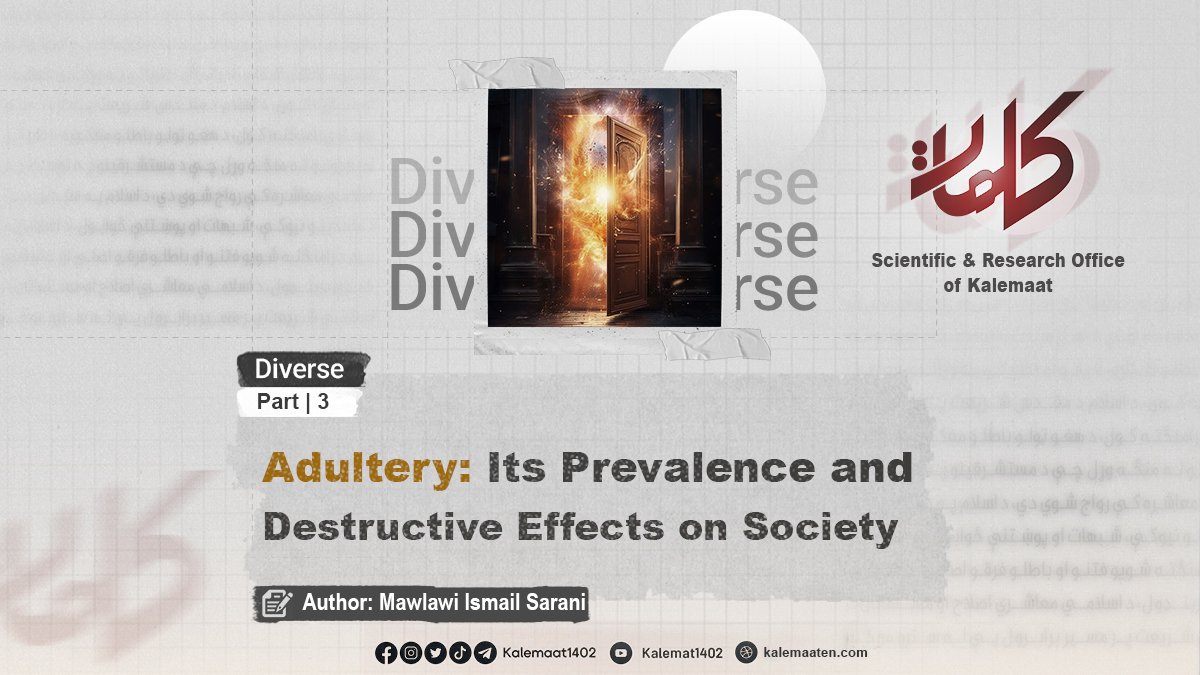
Author: Mawlawi Ismail Sarani
Adultery: Its Prevalence and Destructive Effects on Society (Part Three)
Women in Christianity:
Despite the many emphases in Christian society on avoiding immoral and indecent acts, it has not remained immune to corruption. Some chose monasticism, while others fell prey to carnal desires and committed immoral acts.
It often happened that a church would be located next to a cabaret, where capitalists and pleasure-seekers indulged in lust and debauchery, escaping legal punishment through bribery.
One monk, attempting to discourage men from marrying, said: “If all the fields and gates were made of paper, if all the trees were pens, and if all the writers gathered to write about the evils of women, still they would not be able to expose all the vices and disgraces of women.”
Many believed that women were responsible for all the immoralities and indecencies in society, and they regarded marriage as a vile act that must be strictly avoided.
Chrysostom, one of the prominent Christian scholars, said about women: “A woman is a wicked being that one cannot escape from. She is the temptation of nature, a delightful plague, a ravishing lover, and a decorated calamity.”
Likewise, Tertullian, who is considered an authority in Christianity, said about women: “A woman is the gateway of Satan. It was the woman who persuaded the man to eat from the forbidden tree. She is the one who breaks God’s laws and defaces man’s image.”
Among the early Christians, when they witnessed the widespread immorality, indecency, and extreme moral decay of the Romans, they felt threatened and blamed women for all the corruption and debauchery. This was because women entered public life, enjoyed entertainment and amusement, and freely mingled with men.
They thus decreed that marriage was a source of impurity and must be avoided, and that a celibate person was more honorable in the sight of God than a married one. They declared that a woman is a gateway to Satan and must be ashamed of her beauty, for her beauty is one of Satan’s weapons for creating temptation and deception.
Saint Tertullian further stated: “A woman is the gateway of Satan to the human soul and the destroyer of divine traditions.”
In the 5th century, the Council of Macon convened to discuss whether a woman was merely a physical being without a soul or whether she possessed a soul as well. They concluded that a woman lacks a soul that can be saved from the punishment of Hell—except for the mother of Christ.
Women in Ancient India:
The Indian religion and society, from ancient times, were known for their indulgence in lust and sexual gratification. Perhaps this is because no other religion or land had sexual stimuli so deeply embedded in it as the Indian tradition did.
Indian religious texts and gatherings narrated tales and stories involving divine traits, significant events, and mythical accounts of intercourse among male and female deities—including attacks by some deities on noble families—that are too shameful to even be heard.
The influence of such stories on the minds of devout followers, especially when retold with religious passion and faith, is quite evident.
Moreover, the worship of the genital organ of their supreme deity Mahadeva—and the grotesque way it was depicted—along with the gathering of men, women, children, and girls for its worship, and what some historians report about scholars and sects that worshipped naked women or vice versa, clearly left damaging effects.
Corrupt and treacherous temple priests would often assault female pilgrims and nuns. Many temples had essentially become brothels, where corrupt individuals sought to fulfill their carnal desires.
This makes it clear that if the condition of temples—meant for worship—was like this, then it is easy to imagine the state of the palaces, royal courts, and the aristocracy. These elite families would compete in committing immoral and indecent acts.
They organized mixed-gender gatherings, and as wine goblets circulated, the veil of decency and dignity was lifted. Manners would vanish, and modesty would hide behind curtains. In this way, waves of sexual desire and moral decay swept through the land, and both men and women morally descended to the lowest levels.
The Status of Women in Indian Tradition:
According to ancient Indian law: “Plague, death, hell, poison, snakes, and fire are better than a woman. Her rights end with the rights of her husband, who is her master and owner. So, when she sees her husband’s corpse burning, she must throw herself into the same fire; otherwise, she will be cursed forever.”
Women were offered as sacrifices to the gods either to please them or to obtain sustenance and rainfall. In some regions of ancient India, there was a tree to which the residents would offer a girl each year to be devoured.
According to the Laws of Manu, the Hindu lawgiver who lived more than two thousand years before the advent of the Prophet Muhammad (peace be upon him), it is stated: “A woman in childhood is under the authority of her father, in youth under her husband, and when widowed, under her sons. If none of these exist, she is to be under the care of her relatives, for it is not permissible for her to be independent.”
Among Hindus, eight types of marriages were practiced:
-
Brahma
-
Deva
-
Arsha
-
Prajapatya
-
Asura
-
Gandharva
-
Rakshasa
-
Paishacha
Of these, only two were considered true marriages that preserved the woman’s dignity and honor. The rest were various forms of fornication. It was also common in India for a woman to be the shared wife of multiple brothers.
The codified Indian law stated that for a woman to be considered adulterous, it was sufficient for her to be alone with a man for the time it takes to cook an egg.
Furthermore, in Satyarth Prakash, it is written: “If a woman did not bear children for eight years, if her children died after birth, if she repeatedly gave birth to daughters, or if she had a bad temper, the husband should divorce her as soon as possible and marry another woman.”
Continues…



